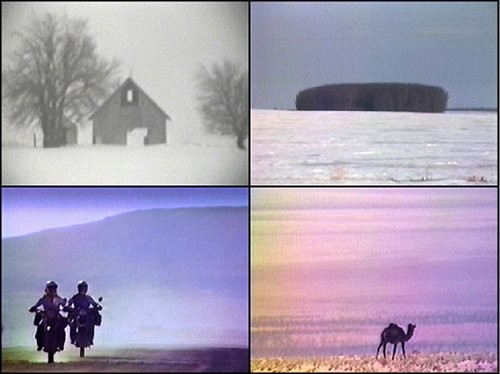From the collection: Ivan Aguéli, Bill Viola
31 Aug - 26 Sep 2010
FROM THE COLLECTION: IVAN AGUÉLI, BILL VIOLA
31 August 2010 - 26 September 2010
When the Swedish artist Ivan Aguéli (1869-1917) went to Paris in 1890, he changed his given name, Johan Gustaf Agelii. He also discovered the art of Paul Gauguin, and Gauguin’s thoughts on art as a synthesis of impressions rather than direct depiction. Accordingly, if we study Aguéli’s works from this period and onwards, they appear as summary interpretations of, say, a landscape. The subject matter appears as though through a slight haze, free of picturesque details.
American artist Bill Viola’s (1951-) video Chott el Djerid – A Portrait in Light and Heat from 1979 begins with snowy landscapes from the Mid-West, then changes abruptly to Tunisian deserts. The magically atmospheric film sequences highlight both optical and acoustic distortions in nature. Mirages arise in the intense desert heat. A physical phenomenon becomes something psychological.
Throughout the 1890s, Ivan Aguéli lived periodically in Egypt, where he was inspired by the landscape and the people, striving for a genuine art, beyond the false facade of the West. In 1898, Aguéli converted to Islam and took the name Abd al-Hâdi (Servant of the Leader). The following year, he travelled to India to study Buddhism, before returning to his nomadic life in Europe and North Africa. In 1917, he was run over by a train in Spain.
Bill Viola studied Zen Buddhism in Japan in the early 1980s. He is also influenced by Islamic Sufism and Christian mysticism. Like Aguéli, Viola incorporates human experience of consciousness and spirituality in his art. Despite their difference in Zeitgeist and artistic techniques, the two artists are related in their quest for something that lies beyond the ordinary. Not in the objects themselves, but in the experience.
John Peter Nilsson, curator
31 August 2010 - 26 September 2010
When the Swedish artist Ivan Aguéli (1869-1917) went to Paris in 1890, he changed his given name, Johan Gustaf Agelii. He also discovered the art of Paul Gauguin, and Gauguin’s thoughts on art as a synthesis of impressions rather than direct depiction. Accordingly, if we study Aguéli’s works from this period and onwards, they appear as summary interpretations of, say, a landscape. The subject matter appears as though through a slight haze, free of picturesque details.
American artist Bill Viola’s (1951-) video Chott el Djerid – A Portrait in Light and Heat from 1979 begins with snowy landscapes from the Mid-West, then changes abruptly to Tunisian deserts. The magically atmospheric film sequences highlight both optical and acoustic distortions in nature. Mirages arise in the intense desert heat. A physical phenomenon becomes something psychological.
Throughout the 1890s, Ivan Aguéli lived periodically in Egypt, where he was inspired by the landscape and the people, striving for a genuine art, beyond the false facade of the West. In 1898, Aguéli converted to Islam and took the name Abd al-Hâdi (Servant of the Leader). The following year, he travelled to India to study Buddhism, before returning to his nomadic life in Europe and North Africa. In 1917, he was run over by a train in Spain.
Bill Viola studied Zen Buddhism in Japan in the early 1980s. He is also influenced by Islamic Sufism and Christian mysticism. Like Aguéli, Viola incorporates human experience of consciousness and spirituality in his art. Despite their difference in Zeitgeist and artistic techniques, the two artists are related in their quest for something that lies beyond the ordinary. Not in the objects themselves, but in the experience.
John Peter Nilsson, curator

